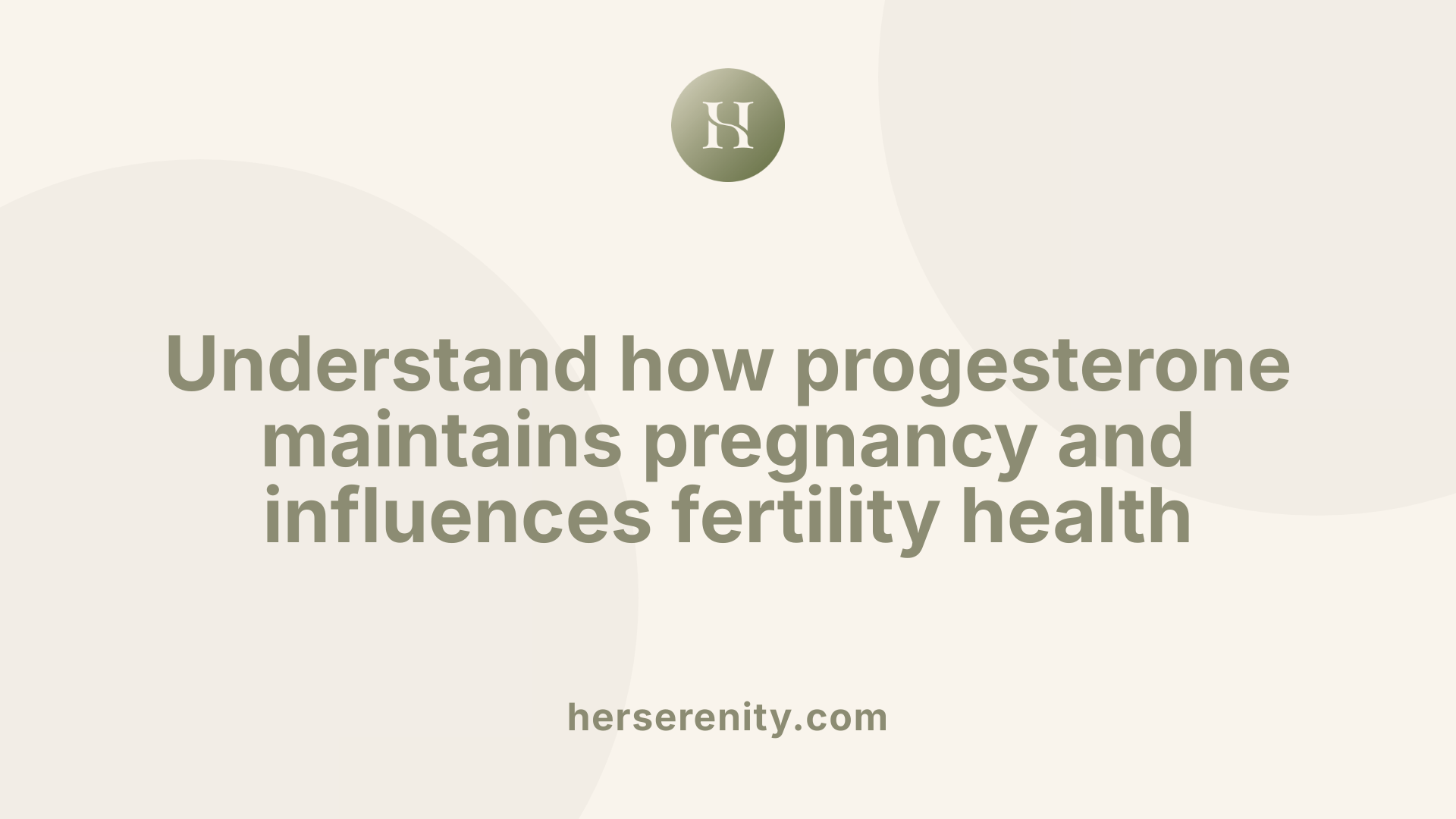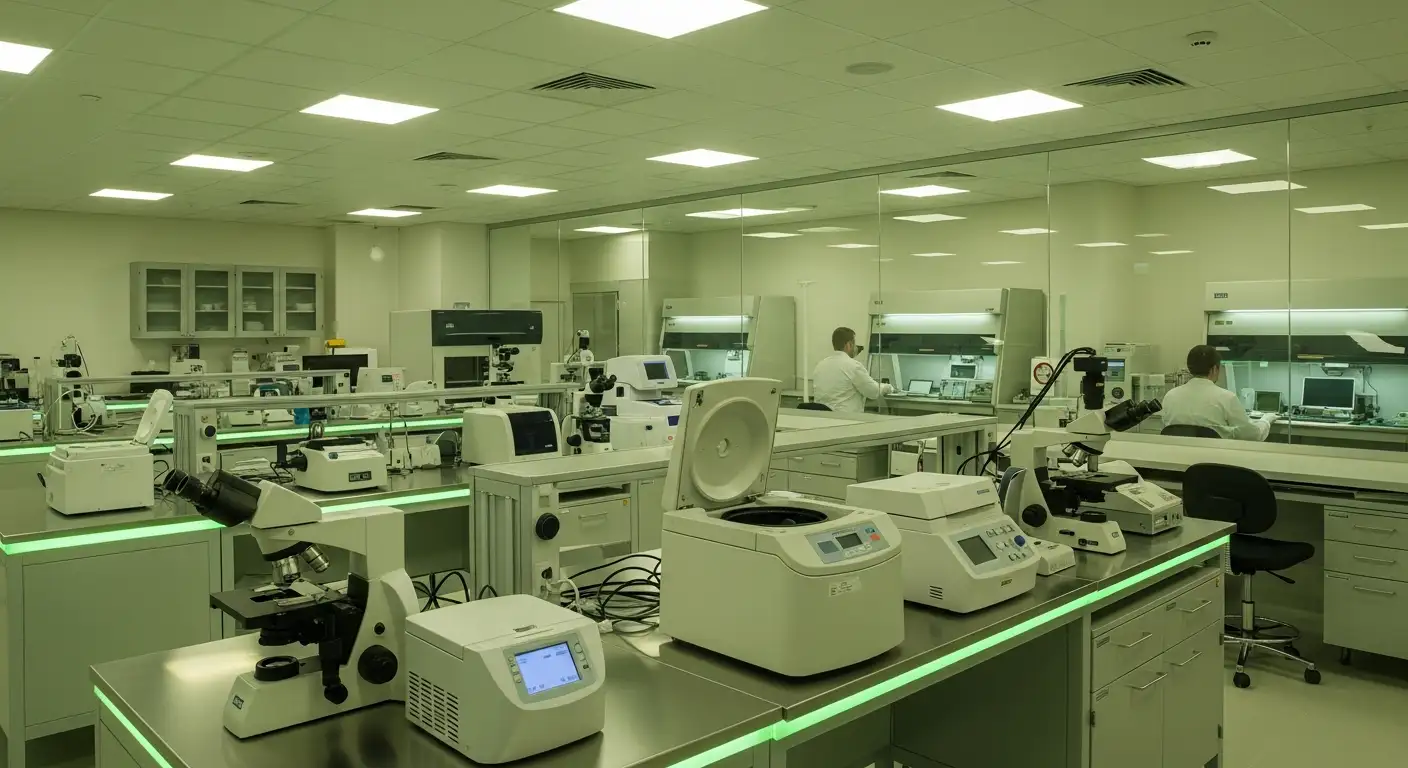Understanding progesterone levels in fertility tracking
The Role of Progesterone in Enhancing Fertility Tracking and Treatment Outcomes

Decoding Progesterone: The Keystone of Fertility Awareness
Progesterone, often dubbed the 'pregnancy hormone', is vital in orchestrating the menstrual cycle, preparing the uterus for implantation, and maintaining early pregnancy. Understanding progesterone levels is essential for individuals and couples navigating fertility challenges, as this hormone not only signals ovulation but also supports the uterine environment crucial for a successful conception. This article explores the significance of progesterone in fertility tracking, its impact on treatment approaches, and how advances in monitoring and supplementation improve reproductive outcomes.
Understanding Progesterone's Biological Role in Fertility

What is the function of progesterone in the menstrual cycle and pregnancy?
Progesterone is a steroid hormone mainly produced by the corpus luteum following ovulation during the menstrual cycle. Its primary function is to prepare the uterine lining (endometrium) for the implantation of a fertilized egg. If fertilization occurs, progesterone levels remain high, stabilizing the uterine lining to support early pregnancy. Without fertilization, progesterone levels drop, triggering menstruation.
How does progesterone prepare the uterus for embryo implantation?
After ovulation, progesterone thickens and transforms the uterine lining into a nutrient-rich, supportive environment, optimized for embryo attachment and growth. It increases markers that signal uterine readiness and reduces uterine contractions, which can help stabilize the embryo during the initial critical stages of pregnancy.
What are the primary sources of progesterone in the body?
Progesterone is mainly produced by the corpus luteum in the ovaries after ovulation. During pregnancy, from about 8 to 10 weeks onward, the placenta takes over progesterone production and boosts its levels to maintain the pregnancy. The adrenal glands also contribute smaller amounts.
How does progesterone support early pregnancy and prevent uterine contractions?
Progesterone maintains the thickened uterine lining and suppresses the maternal immune response to prevent rejection of the embryo. It also inhibits uterine contractions, thereby reducing the risk of early miscarriage and preterm labor. This hormone supports breast development for lactation as pregnancy progresses.
What causes infertility in individuals and couples?
Infertility can result from hormonal imbalances such as insufficient progesterone production, which impairs uterine preparation for embryo implantation and pregnancy maintenance. Additional causes include structural anomalies, genetic conditions, and disorders like polycystic ovary syndrome (PCOS) or endometriosis that may disrupt hormone balance. Lifestyle factors and advancing age can further affect hormone production and overall reproductive health.
Progesterone Levels as Critical Markers in Fertility Tracking

How does progesterone confirm ovulation?
Progesterone, produced by the corpus luteum after ovulation, plays a vital role in signaling that ovulation has occurred. Elevated progesterone levels in the luteal phase, particularly around day 21 in a typical 28-day cycle, confirm the release of a mature egg. This hormone prepares the uterine lining for a potential embryo and helps sustain early pregnancy.
Why is luteal phase progesterone important?
The luteal phase, usually lasting 11–17 days, depends on adequate progesterone production to maintain a supportive environment for implantation. Insufficient progesterone during this phase, known as luteal phase defect, can impair uterine lining preparation, leading to difficulties in conceiving or increased risk of miscarriage.
What methods are used to measure progesterone levels?
Progesterone levels are primarily measured through:
- Blood tests: The standard method for quantifying serum progesterone, often performed on day 21 of the cycle to assess ovulation status and luteal function.
- Urinary hormone testing: Detects progesterone metabolites such as pregnanediol glucuronide (PdG), which indirectly confirm ovulation and luteal health. This method is less invasive and can be used at home.
What is the relationship between low progesterone, luteal phase defects, and fertility issues?
Low progesterone levels disrupt the preparation and maintenance of the uterine lining, increasing implantation failure and pregnancy loss risks. Women with luteal phase defect often exhibit low serum or urinary progesterone levels. Addressing these deficiencies with progesterone supplementation or targeted treatments can improve fertility outcomes.
How do fertility specialists determine the appropriate treatment for a couple?
Clinicians evaluate serum progesterone levels to confirm ovulation and identify luteal phase defects. If progesterone is low, personalized treatments such as progesterone supplementation are introduced to enhance uterine receptivity and support pregnancy. Additional diagnostics may be pursued based on hormone profiles, optimizing the couple's chances of conception.
| Topic | Measurement Methods | Clinical Implications |
|---|---|---|
| Confirmation of ovulation | Day 21 serum progesterone | Validates ovulation and corpus luteum function |
| Luteal phase progesterone role | Blood and urinary testing | Essential for implantation and early pregnancy maintenance |
| Low progesterone impact | Hormone assays | Associated with luteal phase defect, miscarriage, implantation failure |
| Treatment decisions | Progesterone monitoring | Guides supplementation and individualized fertility therapies |
Techniques for Fertility Tracking: Integrating Progesterone Monitoring
What are common ovulation tracking methods?
Tracking ovulation is vital for understanding fertile windows and enhancing chances of conception. Common methods include observing cervical mucus, which becomes clear, slippery, and stretchy during high fertility days. Basal body temperature (BBT) tracking is another approach—temperature rises slightly after ovulation due to increased progesterone, confirming ovulation.
How do urinary progesterone metabolites help in confirming ovulation?
Urinary hormone testing offers a non-invasive way to monitor fertility. Metabolites of progesterone, especially pregnanediol-3-glucuronide (PdG), appear in urine and serve as markers of luteal phase health. Detecting PdG confirms ovulation has occurred and that the body produces sufficient progesterone to support the uterine lining.
What role do digital apps play in fertility tracking and what are their limits?
Digital fertility apps and wearables have become popular tools for ovulation tracking. They often integrate user input with cycle data and biomarker readings. However, their predictive accuracy varies and can be limited when used alone. They work best in combination with physical observations and hormonal measurements.
Why combine different biomarker data for fertility awareness?
A comprehensive approach that combines cervical mucus observations, BBT tracking, urinary hormone testing (including PdG for progesterone), and digital tools provides the most reliable insight into fertility. This integration enables more precise identification of the fertile window, better diagnosis of ovulatory disorders, and improved timing for intercourse or fertility treatments.
By blending various tracking methods, individuals gain a clearer, more nuanced understanding of their reproductive health, optimizing fertility planning efforts.
Progesterone Supplementation: Enhancing Fertility Treatment Success
What are the common forms of progesterone supplementation used in fertility treatment?
Progesterone supplementation comes in several forms, each suited for different needs and preferences. These include vaginal gels, suppositories, inserts, capsules, and injections. Vaginal gels are FDA-approved for use in assisted reproductive technology (ART) and early pregnancy up to 12 weeks, favored for their comfort and ease of use. Suppositories and inserts allow direct local effect, while injections may offer more controlled dosing and systemic absorption.
Why is progesterone therapy indicated in assisted reproductive technology (ART)?
During fertility treatments like IVF, natural progesterone production can be disrupted due to medications stimulating ovulation. Progesterone therapy supports the implantation process by thickening and preparing the uterine lining, creating an optimal environment for the embryo to implant. It also reduces uterine contractions and promotes immune tolerance to help sustain the pregnancy.
How does progesterone support implantation and early pregnancy?
Progesterone enhances markers that signal uterine readiness and maintains the endometrium during the secretory phase following ovulation. After conception, it maintains the uterine lining, prevents premature contractions, and supports the maternal immune system in accepting the developing embryo. Adequate progesterone levels reduce risks of pregnancy loss and miscarriage by stabilizing the uterine environment.
What is the duration and delivery methods of progesterone supplementation?
Supplementation typically begins on the day of or after egg retrieval in IVF cycles and continues through the first trimester, up to 10-12 weeks—when the placenta assumes progesterone production. In some cases, especially those with recurrent pregnancy loss or immune-related fertility issues, supplementation extends to 20-24 weeks. Delivery methods include vaginal, intramuscular injections, oral, and subcutaneous routes, with vaginal forms often preferred for convenience and absorption. Oral pills are less effective due to poor absorption.
| Supplementation Form | Usage Context | Key Considerations |
|---|---|---|
| Vaginal gel | ART and early pregnancy | Comfort, FDA approved, convenient |
| Suppositories/Inserts | Local uterine support | Direct effect, patient tolerance varies |
| Injections (IM, SC) | Controlled systemic dosing | Requires administration, possible discomfort |
| Oral capsules | Less commonly used | Poor absorption, less effective |
This multifaceted approach to progesterone supplementation enhances fertility treatment outcomes by supporting implantation and early pregnancy maintenance.
Advances in Reproductive Technology Improving Progesterone Management
What are some advances in reproductive technology that have improved conception rates?
Reproductive technology has made significant strides in improving progesterone management to boost conception outcomes, especially in assisted reproductive technologies like IVF. Modern progesterone supplementation protocols are now closely tailored to an individual's hormone levels, achieved through precise and regular monitoring of progesterone and related hormones. This optimized approach supports embryo implantation and helps sustain early pregnancy more effectively than before.
Improved methods of progesterone delivery and monitoring
Various delivery methods for progesterone supplementation have been refined, including vaginal gels, suppositories, injections, and subcutaneous forms, each chosen for their specific benefits such as convenience, absorption, and patient comfort. Vaginal gels, for instance, are FDA-approved for use in ART and preferred because they combine efficacy with ease of use. Alongside delivery advancements, hormone monitoring has advanced beyond blood tests to include urinary hormone assays measuring metabolites like PdG, E1G, and LH surges, providing detailed insights into ovulation and luteal phase health.
New technologies for hormone testing and embryo selection
Innovations such as digital tracking apps and wearable devices complement traditional methods, enabling more personalized and accurate hormone monitoring, though their predictive capabilities are enhanced when used in conjunction with biochemical tests. Additionally, preimplantation genetic testing allows for the selection of embryos with the highest viability, improving pregnancy rates when combined with optimized progesterone support.
Impact of optimized hormone protocols on conception rates
The synchronization of progesterone supplementation with precise monitoring has led to higher implantation rates and reduced early pregnancy losses. By ensuring sufficient hormone levels at critical phases, these protocols lower miscarriage risk and support pregnancy progression, contributing to increased live birth rates.
Tailoring progesterone treatment based on monitoring to enhance outcomes
Personalized care is now standard, where progesterone dosage and duration are adjusted based on real-time hormone level assessments. This strategy prevents under- or over-treatment, helping patients with varying progesterone needs, including those with recurrent miscarriage or immune-related fertility issues, ultimately improving success rates and patient well-being.
Addressing Emotional and Psychological Dimensions in Progesterone-Related Fertility Care
What are the emotional and psychological impacts of fertility treatments on patients?
Fertility treatments that involve progesterone supplementation often lead to hormonal fluctuations that can result in mood swings, anxiety, and depression. These emotional challenges are compounded by the physical demands of treatment and the stress of uncertain outcomes. Additionally, societal pressures and personal expectations can intensify feelings of distress and frustration.
Emotional aspects of monitoring and supplementation
The process of tracking ovulation and progesterone levels requires frequent testing, which can be emotionally draining. The anticipation tied to blood tests, hormone level results, and treatment adjustments may increase anxiety and stress for patients trying to conceive.
Supportive care and counseling to mitigate stress and emotional challenges
Integrating psychological support and counseling into fertility care is crucial. These services offer patients safe spaces to express their emotions, learn coping strategies, and receive reassurance. Relaxation techniques and stress management programs can also help ease emotional burdens during hormonal treatments.
Importance of holistic approaches in fertility treatments involving progesterone
A comprehensive fertility treatment plan addresses not only physiological needs but also mental well-being. Holistic approaches combine medical management with psychological support to improve treatment outcomes and enhance patients' quality of life during their fertility journey.
Progesterone's Pivotal Place in Fertility Tracking and Treatment
Progesterone is central to reproductive health, serving as both a marker and mediator of fertility. Accurate monitoring of progesterone levels informs effective fertility tracking and guides tailored treatment strategies that improve conception chances. Advances in hormone measurement and supplementation methods continue to refine fertility care, offering hope to many individuals and couples. Importantly, acknowledging and addressing the psychological effects of fertility treatments enriches patient support and optimizes overall outcomes. Understanding progesterone’s multifaceted role empowers patients and clinicians alike in the journey toward successful conception and a healthy pregnancy.
References
- Progesterone and Pregnancy: A Vital Connection | RESOLVE
- Current ovulation and luteal phase tracking methods ...
- The Role of Progesterone in Fertility Treatments
- Progesterone: Natural Function, Levels & Side Effects
- Role of Progesterone in Reproduction and Pregnancy
- Day 21 Fertility Testing: Progesterone Levels, FAQs & What ...
- Progesterone supplementation during IVF patient ...
- Fertility Test: Checking Progesterone Levels


































































































